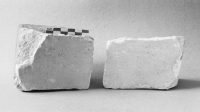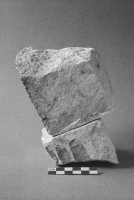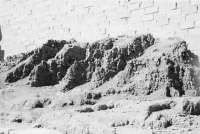http://www.global.tdk.com/techmag/inductive/vol3/index.htm
[
книга;
Experiments in Egyptian Archaeology; Stoneworking technology in Ancient Egypt (Denys A. Stocks 2003)
page 194;
Friction and force: physics to the rescue
The Egyptian craftworker was always fighting gravity and friction when moving
large stone blocks (Figure 7.16). Let us consider how much force was needed to
slide the casing-blocks across each other in the Great Pyramid. C.A. Coulomb45
conducted a large number of experiments appertaining to the question of friction
between clean, dry surfaces. Coulomb’s results are the basis for the laws of friction,
and S. Timoshenko and D.H. Young46 have summarized them as follows:
Figure 7.16 Large stone blocks accurately fitted to their supporting pillars in the Osireion
at the rear of the temple of Abydos
M A S T E R M A S O N R Y F I T T E R S
1 The total friction that can be developed is independent of the magnitude of
the area in contact.
2 The total friction that can be developed is proportional to the Normal force.
(The Normal force is that force acting upon two surfaces being pressed
together.)
3 For low velocities of sliding the total friction that can be developed is practically
independent of the velocity, although experiments show that the force
F necessary to start sliding is greater than that necessary to maintain sliding.
The formula F = μN expresses these laws of friction, where μ (mu) is called the
coefficient of friction and N is the Normal force – expressed in Newtons. (A
Normal force of 1 kg pressing two surfaces together is equal to 9.8 Newtons at
sea level.) If F is taken as the force necessary to start sliding, μ is called the
coefficient of static friction. If F is taken as the somewhat smaller force necessary
to maintain sliding, μ is called the coefficient of kinetic friction. In this study, only
the greater force necessary to begin sliding will be considered.
Sliding tests required a surface on each of two small blocks of soft limestone to
be flattened and smoothed to a tolerance of 0.25 mm (Figure 7.17). The prepared
blocks’ dry flat surfaces were placed in contact, one block above the other, the
bottom block being slowly tilted until the top block just began to slide across its
surface. Several tests revealed an average angle of tilt to be 36°.47 The tangent
of this angle gives a coefficient of static friction of 0.73.
Several sliding tests were repeated with liquid mortar applied to the bottom
block’s top surface. The upper block now commenced sliding at an average angle
 Figure 7.17 Two small limestone blocks, each with a surface flattened to a tolerance of
Figure 7.17 Two small limestone blocks, each with a surface flattened to a tolerance of
0.25 mm
 Figure 7.18 The lubricated sliding test using the prepared limestone blocks
Figure 7.18 The lubricated sliding test using the prepared limestone blocks
of 8°, giving a coefficient of static friction of 0.14 (Figure 7.18). Other experiments
revealed that a wooden sledge runner on liquid mud produced a similar coefficient of static friction.
One of the existing casing-blocks on the northern side of the Great Pyramid
weighs approximately 16,300 kg. To find the force, F, to start this block to slide
dry on a flat and smoothed stone surface, its weight must first be converted to the
Normal force, N, in Newtons, i.e. 16,300 × 9.8 = 159,740 Newtons. The sliding
force, F, can now be calculated by multiplying the coefficient of static friction of
0.73 by the Normal force, N. F = 116,610 Newtons. To find the force, F, starting
the same block sliding on a surface lubricated with liquid mortar, the coefficient
of static friction of 0.14 must be used. F = 22,363 Newtons.
These results show that over five times less force is needed to start a lubricated
block moving than that of a dry block. This reduction factor of five applies to all
blocks, no matter what their weight and area of surface contact.
In the Twelfth Dynasty tomb of Djehutihotep, at el-Bersheh,48 Upper Egypt,
there is an illustration of an alabaster statue of him, thought to weigh about
60 tonnes; 172 men are hauling it along a level surface on a sledge. A man
is pouring some liquid, probably water, in front of the sledge’s runners to
maintain a muddy track. Calculations show that each worker needed to pull with
a force of 478 Newtons (about 49 kg) in order to start the statue moving from rest.
The Djehutihotep illustration suggests that
one worker was capable of initiating
and maintaining a pulling force of about 500 Newtons (about 50 kg). Therefore,
about
45 workers could have started a
lubricated 16,300 kg block moving on a
horizontal surface. Once started, the force required to keep the block moving
would drop, allowing it to be pulled forward at a constant rate. A smaller,
lubricated Great Pyramid casing-block of about 2,750 kg, this weight calculated
from the average size of the core- and casing-blocks, required the initial force to
be 3,770 Newtons (about 385 kg). Eight workers could easily start a block of this
weight moving on a level surface.
The experiment with the mud-lubricated sledge runner explains why the angle
of slope for some ancient ramps (Figure 7.19) was less than 8°. For example, a
Nineteenth Dynasty papyrus in the British Museum49 gives some measurements
for a hypothetical ramp. A scribe, Hori, asks another scribe, Amenemope, how
many bricks are needed to make a ramp of 730 cubits (383.25 m) in length,
55 cubits (28.9 m) in width and a height of 60 cubits (31.5 m). Calculations
indicate that the ramp’s gradient is 1 in 12, or nearly 5°. The gradient of the ramp
left in the unfinished Fourth Dynasty mortuary temple of Menkaure is about 1 in
8, or just over 7°.50 Also, two stone-built loading ramps, excavated at the southern
end of the Gebel el-Asr region, Lower Nubia,51 where gneiss was extracted from
the quarries there, both measured approximately 9 m in length and 1.2 m high at the front, again giving a gradient of 7°.
Sliding laws state that twice the force for pulling a block along a level surface is
required to pull a block up an incline at an angle equal to the angle at which it
is about to slide backwards52 – nearly 8° on a mud-lubricated ramp and nearly 36°
on a dry ramp surface. An ideal lubricated ramp’s gradient is 1 in 8. However, a
 Figure 7.19 Remains of a mud brick ramp in the Karnak temple, Luxor
Figure 7.19 Remains of a mud brick ramp in the Karnak temple, Luxor
ramp of 1 in 12 is quite adequate, completely eliminating the risk of an unattended
block sliding backwards. Ramps sloping upwards at 8°, and higher, are
likely to have been used dry, it being both counter-productive and dangerous to
lubricate such a ramp.
I.E.S. Edwards53 favoured a single supply ramp, constructed at 90° to a
pyramid’s side, for hauling the blocks up.54 Calculations show that if a 7° (1 in 8)
ramp was constructed in ancient times it needed to be a maximum 1,100 m in
length. This is about three times longer than the hypothetical ramp in the British
Museum papyrus. However, by changing the ramp’s direction through several
turns it didn’t need to extend 1,100 m in a straight line from the face of the
pyramid while maintaining a similar inclination along its whole length.
Petrie estimated that the skilled masons employed permanently at Giza for the
building of the Great Pyramid numbered between 3,400 and 4,000.55 Herodotus
stated that he was informed that the number of workers employed for transporting
the stones in the inundation was 100,000, the pyramid being built in 20 years.56
However, recent excavations carried out at a Fourth Dynasty industrial site at
Giza by Zahi Hawass and Mark Lehner,57 and subsequent assessments of the
archaeological and scientific evidence, indicate that a maximum 20,000 skilled
Egyptian masons and labourers were employed for 20 years to build the Great Pyramid.
The experiments with the three replica surface-testing tools indicate their
presence at Giza in the Fourth Dynasty: they, alone, could have enabled craftworkers
accurately to prepare the limestone blocks fitted into the Great Pyramid
of Giza. The sliding experiments revealed significant advantages in moving stone
blocks, and loaded sledges, along mortar- and mud-lubricated horizontal and ramp surfaces.












